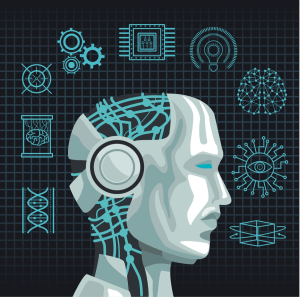You’re already familiar with the first generation of digital helpers—Siri, Alexa, Cortana, Google Assistant, Bixby, and a few others. If you have one at home (or at least in your pocket) they’re proving to be pretty capable at a variety of everyday personal tasks: checking scores or the weather, playing tunes, setting an alarm, turning on lights, or calling an Uber.
In the U.S. alone, one in six consumers, or nearly 40 million people, already have a smart speaker in their home. And nearly two thirds of this group of early adopters say they wouldn’t go back to a life without one of these devices . Yet home-based speakers are just one puzzle piece of the voice platform. According to a forecast from eMarketer, over 5 billion assistants will be installed on smartphones worldwide by 2022.
Exciting (and profitable) as all that sounds, the home invasion of voice assistants masks a much bigger story following on its heels—how next-gen technologies like AI, virtual assistants, and chatbots will become equally indispensable tools in the workplace, and how they will change the nature of work itself. As Gartner research vice president Mike Rollings explained recently, “There is tremendous opportunity for enterprises to use artificial intelligence to reinvent how business is done by cultivating and using intelligence.”

The first phase of this is already happening: companies are experimenting with AI-enabled chat and voice-activated assistants to handle things like self-servicing customer help questions, ordering office supplies, and scheduling meetings.
All well and good, since offloading these simple tasks to technology saves time and money and frees up employees to be more productive and focus on higher-level work. But effectively swapping out admin chores with digital assistants represents just the first wave of adoption. The higher calling of these next-gen technologies, as they shift from consumer into the enterprise, centers around how they can automate the more burdensome and complex aspects of actual work—automating workflows, managing teams and projects, pulling numbers and filing reports, qualifying sales leads, onboarding employees, planning, tracking, and so on.
All of this digitally-enhanced functionality in the workplace is within reach over the next few years. But getting there won’t mean just buying, as Amazon has said, “an Echo for every boardroom.” It will be about creating intentional bridges between text- and voice-enabled AI and popular business apps like Slack, Salesforce, DropBox, Microsoft Teams, and Gmail that people use to get work done every day.
Enterprise work execution platform, Smartsheet, for instance, recently acquired Converse.AI – a maker of bots for business automation. The company plans to use Converse.AI’s platform to enable “intelligent conversational workflows” over a range of business functions that leverage chat and voice-enabled AI. For example, companies could use a chat interface to guide a new employee through an onboarding process and – with AI – can tailor questions and information based on the employee’s role, with relevant data sent to HR or other teams as appropriate. In the future, workers could also take advantage of Amazon Alexa integrated into their vehicle to track and manage work en route to the office.
Another example of an investment in this space is is Cisco, which made a $125 million acquisition of AI company MindMeld last year to bring conversational interfaces into their collaboration suite.
With these technologies ushering in the intelligent era of work execution and management, organizations have an opportunity to capture significant gains in revenue, efficiency, innovation and worker satisfaction. While the appeal of voice and chat-enabled AI may be most obvious among consumers, their real value will undoubtedly be realized in the enterprise.